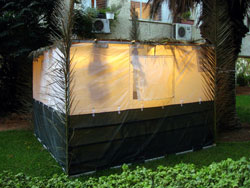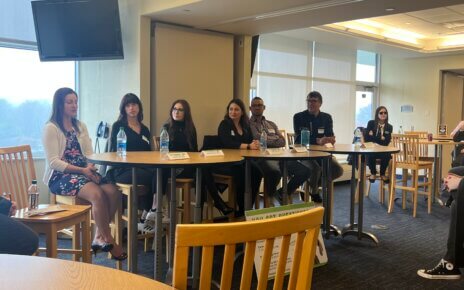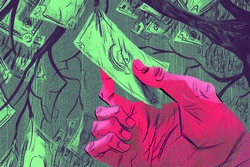In Oct., a simple structure with outer walls clothed in a light blue tarp took residence in front of the Rebecca Stafford Student Center (RSSC). This makeshift edifice was a sukkah, and it was built in celebration of the Sukkot holiday by members of the Jewish Chabad.
Sukkot began on Sunday, Sept. 27 and lasted through Sunday, Oct. 4. Annually, this holiday recognizes the plights of Jewish ancestry. “The Jews were slaves in Egypt, and when they were freed they wandered in the desert for 40 years. When they were in the desert, God made a few miracles happen for them,” said Yaakov Greenberg, a Rabii in the Monmouth County Jewish community.
“There were three main miracles; one was the manna, where they had special food from heaven while they were in the desert. Second was the water, which came from Mariam, who was Moses’s sister. And third was the Clouds of Glory, that protected the Jews from enemies who wanted to attack them,” he continued.
According to jewfaq.org, Sukkot literally means “Feast of Booths”. It is one of many Jewish holidays that is based on the lunar calendar. Throughout the eight days of Sukkot, Jews are required to eat their meals in the sukkah structure. “A lot of students utilized the sukkah this year. During one of the days we had a Chinese dinner and a lot of Jewish students attended,” said Mitchell Parker, the Vice President of the Jewish Chabad.
Nash Wiener, a Jewish communication student, said that he has enjoyed Sukkot since he was a child in Hebrew school. “I think it is a very unique holiday. The fact that it centers around the sukkah and everyone eats their meals in it is so much fun,” he said. “When I was younger in Hebrew school, building the sukkah was always my favorite thing, so it is always a nice memory seeing one on campus,” he said.
Greenberg explained further the religious context of the holiday. “To symbolize the miracles we put a structure around us and we sit outside just like the Jewish people sat outside when they were in the desert. It comes from the Bible. It’s actually a commandment in the Torah in the Bible, and it says that for seven days, to commemorate what happened to the Jewish people, we should sit in such a structure,” he said.
According to Greenberg the structure of the sukkah has universally recognized criteria. “Moses explained to the Jews exactly how it [the sukkah] should be, and that’s why they are all the same. It is four walls, the minimum is 2 1/2 in order for it to be kosher. There are many other details as well, for example, the walls have to be strong enough for wind not to knock it down,” he said.
Weiner appreciated the sukkah’s presence at the University. “I think it was awesome that there was a sukkah on campus. Everyone always stops and wonders what it is, and to me that does wonders. It shows that people find it interesting,” he said.
Some students also noticed the local Jewish community engaging in the holiday traditions of Sukkot. “I live around here and I noticed a lot of Jewish people walking around near the beginning of the month. They carried some long plants in their hands, and I know that during certain holidays Jewish people can’t drive,” said Maya Ayubi, a biology student.
“You have days of the holiday called Chag, where you cannot perform any transgressions that would go against the Sabbath. These are the first two and the last two days of Sukkot. On these days, Jewish people go to services, and we can’t do things that we would regularly do, like work or drive,” said Parker.
Sukkot commenced while classes were in session. According to Parker, some Jewish students were academically affected by the four days of Sukkot where Jews had to restrain from certain activities. “The Chag days mainly had an effect on religious Jewish students. I had to ride my bike to class, because I couldn’t drive. Some of my friends missed classes,” he said.
“Everyone has different levels of religiosity. So on Chag days some Jewish students would ride their bikes and take notes. Some would ride their bikes and not take notes. Some people just didn’t go to class, since you are not allowed to write or take notes on your computer,” continued Parker.
“The sukkah we built here was made with metal poles that were drilled together to provide the framework. Then the tarp material that was surrounding it we just kind of put around it. The roof was the most important part really, it is called a schsca. It is important because we have to see the stars at night like our ancestors did while they were in the desert,” he said. “The other thing is it has to have four sides and at least one opening. The opening is to welcome people into our tent, because one of the huge tenets of Judaism is to be welcoming to other people,” said Parker.
Although he has never noticed the sukkah before, Dr. Golam Mathbor, the Chair of the Philosophy, Religion, and Interdisciplinary Studies program, thinks that such forms of religious representation are beneficial to the University environment.
“I firmly believe all religions need to be recognized on campus. I feel that will bring cultural awareness and religious diversity to our Monmouth community,” he said.
IMAGE TAKEN from https://upload.wikimedia.org/wikipedia/commons/b/b1/Sukkah.jpg




